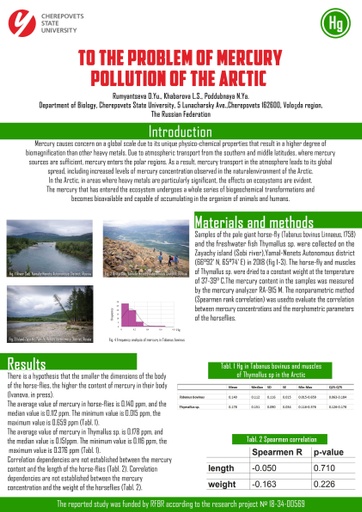pdf To the problem of mercury pollution of the Arctic Popular
2010 downloads

Olga Rumyantseva
Department of Biology, Cherepovets State University, 5 Lunacharsky Ave
Khabarova Liubov, Department of Biology, Cherepovets State University, 5 Lunacharsky Ave, Cherepovets 162600, Vologda region, The Russian Federation
Poddubnaya Nadezhda, Department of Biology, Cherepovets State University, 5 Lunacharsky Ave, Cherepovets 162600, Vologda region, The Russian Federation
 Mercury causes concern on a global scale due to its unique physico-chemical properties that result in a higher degree of biomagnification than other heavy metals. Due to atmospheric transport from the southern and middle latitudes, where mercury sources are sufficient, mercury enters the polar regions. As a result, mercury transport in the atmosphere leads to its global spread, including increased levels of mercury concentration observed in the natural environment of the Arctic. Studies of lake deposits, soils and tissues of organisms have shown that the current concentrations of mercury in the Arctic are on average three times higher than in the pre-industrial era. According to existing models of mercury transport, most of it reaches the Arctic by air. However, the greatest influence on the hydrobiota is rendered by mercury, carried by the rivers flowing into the Arctic Ocean. In the Arctic, in areas where heavy metals are particularly significant, the effects on ecosystems are very evident. The mercury that has entered the ecosystem undergoes a whole series of biogeochemical transformations and becomes bioavailable and capable of accumulating in the organism of animals and humans. The reported study was funded by RFBR according to the research project № 18-34-00569.
Mercury causes concern on a global scale due to its unique physico-chemical properties that result in a higher degree of biomagnification than other heavy metals. Due to atmospheric transport from the southern and middle latitudes, where mercury sources are sufficient, mercury enters the polar regions. As a result, mercury transport in the atmosphere leads to its global spread, including increased levels of mercury concentration observed in the natural environment of the Arctic. Studies of lake deposits, soils and tissues of organisms have shown that the current concentrations of mercury in the Arctic are on average three times higher than in the pre-industrial era. According to existing models of mercury transport, most of it reaches the Arctic by air. However, the greatest influence on the hydrobiota is rendered by mercury, carried by the rivers flowing into the Arctic Ocean. In the Arctic, in areas where heavy metals are particularly significant, the effects on ecosystems are very evident. The mercury that has entered the ecosystem undergoes a whole series of biogeochemical transformations and becomes bioavailable and capable of accumulating in the organism of animals and humans. The reported study was funded by RFBR according to the research project № 18-34-00569.

